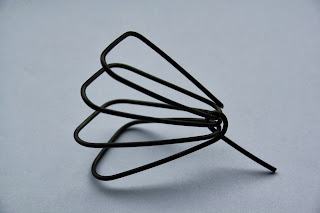Tony Cragg's Sculptures
The main piece of Tony Cragg's which I looked at was the
sculpture pictured below called 'Red Square'. I found the way that this piece
looks as if it's one piece of material which has been twisted around into
different shapes really intriguing. It made me immediately want to experiment
more with paper and find all the different shapes and forms I could make with
it by twisting it around and through itself. The small gap all the way around
the piece also interested me because it made me think about how we will never
know what's on the inside of the piece. He has left a small gap for us to look
through but there's not enough room for us to fully explore the inside of the
piece and see if he's left anything hidden inside.
Based on this piece I created my own response using paper. I tried to include the natural shapes and curves which Tony Cragg uses and not force the paper too much by folding or scrunching it as that way it would lose the natural beauty. I also chose to use plain paper as, much like Tony's work, this would lead to the focus being on the forms created. Finally, the main piece of inspiration I took from the 'Red Square' piece was the viewer not being able to know what was inside. I deliberately made the sides of my piece higher than the middle therefore from all side angles - except one which gives a brief glimpse of what's inside - the piece looks very plain. However, when viewed from above, you can see straight into all the layers beneath. It gives the viewers the chance to explore the whole piece of they are willing to investigate it and look from all angles.
 |
| View from front |
 |
| View from back |
There are many similarities between Barbara Hepworth and
Tony Cragg's work as they both create natural, large, round sculptures.
However, I think where Cragg's work may be slightly more detailed with the shapes
being repeated or curving in and out and twisting around itself, Hepworth's
work is generally plainer with one large shape. She also often likes to use large
holes in her sculptures where Tony Cragg doesn't. Because her sculptures are
larger and plainer, I think these holes are successful as they provide a break
from the thick main piece and make it seem lighter. Because Tony Cragg's
sculptures aren't made of such a bulk of material, I don't think the holes
would be as successful in his work.
| Barbara Hepworth |




